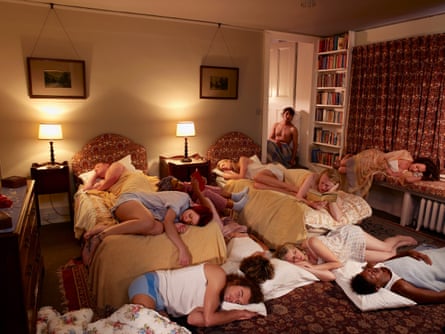In an interview with BBC’s Radio 1 in October, actress, author and denim enthusiast Julia Fox shared her secret for getting to sleep at night.
“I sleep with the hairdryer on,” she said.
She went on to explain that she’s been doing it since she was eight or nine years old, and that she likes the white noise. “Some feedback I get is mixed,” she admitted. (The radio show posted a clip of the interview on Instagram, interspersed with warnings in big red letters that say: “FIRE RISK! DO NOT DO THIS! YOUR BED WILL CATCH FIRE!”)
Potential fire hazards aside, who among us does not have our own metaphorical, sleep-time hair dryer? Some people can close their eyes and instantly drop into a deep slumber. But others need a specific set of routines, conditions or mental exercises to signal to our brain that it is time to release its grip on consciousness.
“Sleep is inherently a dangerous activity,” says Dr Rafael Pelayo, a sleep specialist and clinical professor of psychiatry and behavioral sciences at Stanford University. During sleep, you’re letting your guard down, Pelayo explains. You’re giving up control and theoretically, anything could happen. In order to surrender to this vulnerable state, he says, “you have to feel safe, comfortable and loved”.
Sleep routines allow us to feel like we have control over our environment and that we are safe, which makes it easier for us to doze off. What works differs from person to person; as Pelayo says, “everybody in the world sleeps”, and there are as many ways of sleeping as there are people. But whatever your routine is, he says, it should above all be pleasant. “Any routine that adds to your serenity is going to be helpful to you.”
We asked readers about the routines, items and practices they need to fall asleep. They painstakingly listed the snacks, alphabet games, mantras and elaborate soap operas they’ve been mentally directing for years.
If you’re unhappy with your own sleep routine, maybe some of these techniques will inspire you. And if they don’t, don’t lose hope. Pelayo notes that sleep is a learned behavior, and that humans are very adaptable. “People often say, ‘I’ve tried everything,’” Pelayo says. “But they’ve only tried everything for a day or two. They’ve not done it for two, three, four months. That’s how we develop habits.”
Drink a cup of warm milk
Turn down the air conditioning to the low-60s and turn on the ceiling fan. If it’s very cold outside, I don’t use the AC. At 9pm, heat a demitasse-size cup of milk in the microwave to almost scalding. Climb into bed. My Jack Russell mix joins me, snuggling up next to me on a blanket totally separate from my bedding. I cover him with a baby blanket. (I know.) I drink the milk while doing a sudoku or watching funny animal videos. When the milk is gone, I turn off the light and turn on my favorite sleep story in [the meditation app] Calm, put on my sleep mask, and wake up the next morning at 5.30 or 6.00. Jen, 58, Texas
Fantasize about elaborate home renovations
I have a specific routine whereby I meticulously plan renovations to a room in my house and visualize this as I’m going to sleep, in elaborate detail (read: cupboard handles and style of skirting). If my sleep is particularly poor, I will plan a renovation of the whole house. This technique really helps soothe ruminating thoughts for me, as bizarre as it sounds, and I have done it for years. I have yet to renovate my entire house though, in reality! Anonymous

Stress and worry keep me up, so once I turn out the lights, I mentally design fantasy houses in various locations. I create them in detail over many nights or weeks, inhabit them in various seasons, weather, times of day and edit as needed. Some are very simple, some are rather full-featured. Building and inhabiting my own creatively constructed spaces is quite relaxing, I find. Jen, 58, Oklahoma
Install an indoor fountain
I use two blackout blinds, one in the recess and one over it. For help with my tinnitus, I use a white noise machine. I also installed an indoor fountain in my bedroom, which works on a timer for a couple of hours until after I should have dropped off. When I can’t get to sleep, I pretend someone is looking around the door and I have to convince them I am asleep, like a child might to a parent. I make a production of it: big breath noises, snoring almost. I also fake rapid eye movement sometimes, which is easy when you think about it. The trick is not to stop, to keep on until I fall asleep. It works a dream. Charlie, 60, Hackney, UK
Imagine your future self being jealous that you’re in bed
Whenever I have trouble falling asleep, I imagine how jealous of my current self I will be in the morning. “Oh, to be that person at 12am laying in bed again,” I inevitably think, waking up after not enough rest. Simply imagining this state makes me appreciate my being in bed and puts me to sleep without fail. Thomas, 25, New York

Bury yourself in pillows, pillows and more pillows
I require at least five and sometimes more pillows: one under my head (normal), one stuffed under my chin, one between my arms (sometimes this can be the same as the chin pillow, depending on size), one between my legs, and one to two pillows piled on top of my face. Sometimes I also pile one of those lavender-filled heavy neck pillows on top of the face pile, for additional weight. I must feel as if I am being buried alive in a pleasant way. Then (or actually, beforehand, because I can’t move at this point), I turn on my white noise machine as loud as I can. I also turn on a purposefully very loud fan that sits in the corner of the room. Finally I ask my partner to lower the blackout shade. When the veil between worlds is thin I can finally rest. Rachel, 36, New York
Play alphabet games
I have a specific technique that works for me: think of an object, then play the alphabet game on it. For example, I sometimes choose a commercial plane, like a jumbo jet, then try to list all the things related to that which start with the letter ‘A’. Once you run out of As, you move to B, etc. It engages just enough of my brain to block everything else, and is absolutely boring enough to knock me out. I have never made it past ‘E’. Anonymous

I find it hard to switch my brain off. So I choose a category (animals, countries, Pokémon, episodes of Buffy the Vampire Slayer) and slowly list them alphabetically in my head, taking a deep breath for each until I fall asleep. I rarely get as far as P for Pikachu, but if I finish the alphabet I go through them all again with different answers. It helps me stop ruminating on stuff that would otherwise keep me up all night. Rachel, 35, Devon, UK
Do math
A hot shower and weed are part of my routine. I usually fall asleep easily, but when I can’t sleep, I try to do math problems in my head. For some reason, my brain doesn’t want to deal with anything that precise and will usually drift off before I can finish the problem. This probably wouldn’t be true if I were a great mathematician, but I’m not. Carole, 78, California
I rarely have trouble falling asleep, but when I do, I pick a large number (say, 822) and start subtracting 7 from the number over and over again. (815, 808, 801, etc.) I have never reached zero. Bob, retired, Pennsylvania

Make up your own long-running, gentle soap operas
I have a couple of [made up] storylines going all the time. Once I’ve decided to sleep, I start one of the stories, establishing the season, time of day and weather. First, I try to remember everyone’s names, then how they are dressed. I design all the clothing, hairstyles, jewelry, etc. Finally, if I am still awake – which is rare – I choose the action of the scene. The action involves normal, everyday things people do in life. There are occasions of excitement, but mostly it is routine. I think of them as slow-moving soap operas, so basically I bore myself to sleep, usually within minutes. Baldwin, retired, Oregon
Nothing. Nothing. No-thing.
The following has been particularly effective for me to fall asleep if I have thoughts racing through my head. I silently chant the word “nothing,” with “no” on the inhale and “thing” on the exhale. Usually I fall asleep within minutes, or at least that’s what I perceive. The word signifies to me the state I wish to be in. Thinking of nothing. Matthew, 73, Maine